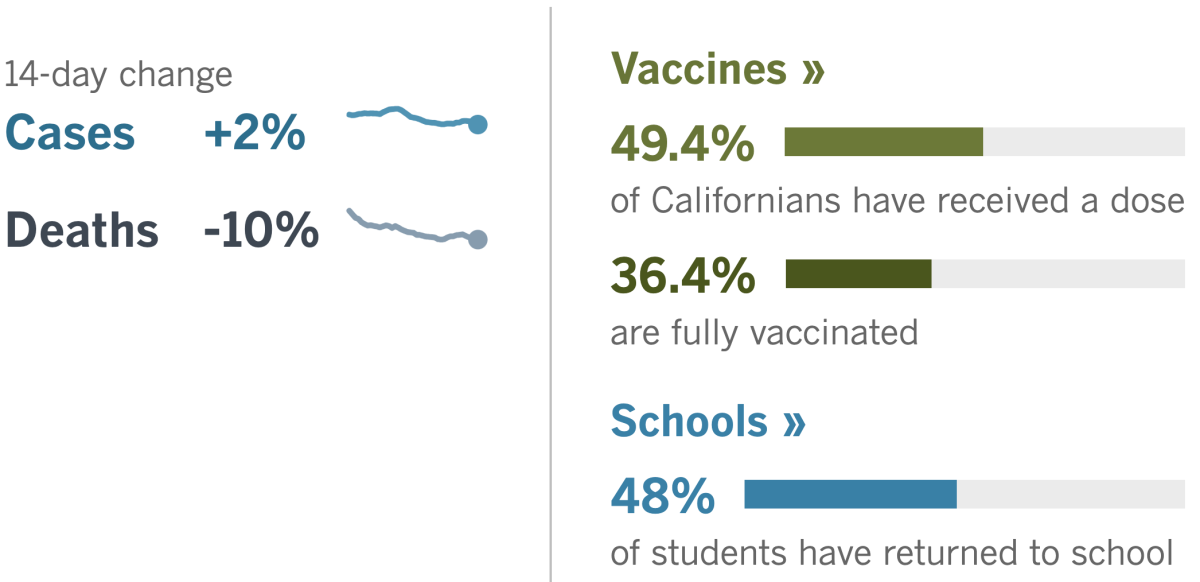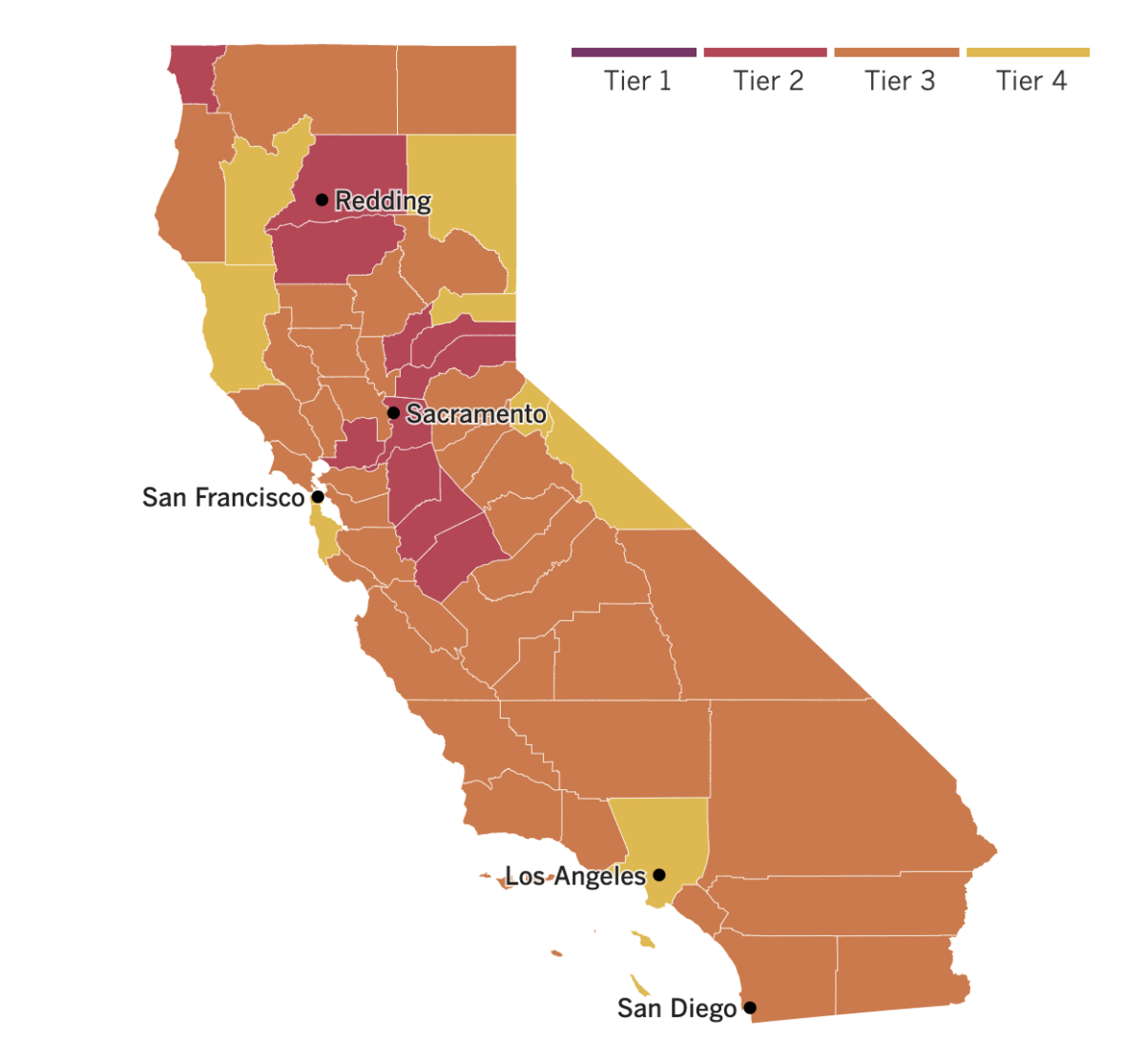Coronavirus Today: Rethinking herd immunity
Good evening. Iâm Kiera Feldman, and itâs Tuesday, May 11. Hereâs whatâs happening with the coronavirus in California and beyond.
During the darkest days of the pandemic, I couldnât shake the grim fear that vaccines would never be enough to stem what had become a daily mass-casualty event. L.A.âs hospitals were running low on oxygen, ambulances were forced to wait for hours before unloading patients, and air quality regulations had to be lifted so crematoriums could process the backlog of bodies.
How quickly things change. COVID-19 vaccines have proved effective beyond my wildest hopes. But for some commentators, itâs not enough to stop them from fretting about whether or not weâll reach herd immunity.
Stop obsessing about herd immunity, my colleague Michael Hiltzik argues in his latest column. He says weâve got the concept all wrong. Whatâs causing confusion is that many of us non-scientists are equating herd immunity with the complete eradication of the virus.
âThatâs not what infectious disease doctors mean by âherd immunity,ââ said Dr. Monica Gandhi of UC San Francisco. âUnfortunately, weâve only eradicated a single virus in the history of mankind, and that is smallpox.â
While some people debate the precise vaccination levels constitutes herd immunity, getting hung up on a specific number isnât a worthwhile exercise, Hiltzik writes.
He reminds readers that the math that matters is simple: The higher the percentage of people who have been vaccinated, the faster transmission will fall. New cases will decline even before the population reaches full herd immunity. In fact, thatâs already happening.
We would do well to remember other highly infectious diseases that have been made manageable through widespread vaccinations: measles and polio. The latter is considered eradicated from the Western Hemisphere, though outbreaks still occur in less developed regions.
Weâll be able to rest easy when COVID-19 is tamped down enough to be manageable.
âThe idea of trying to reach âherd immunityâ as if suddenly thereâs going to be this magic day when we can all go back to normal and the virus is completely gone â thatâs probably a fantasy,â said Dr. David Dowdy, an epidemiologist at Johns Hopkins Bloomberg School of Public Health. âBut getting the virus to a tolerable level where we donât have to alter our way of life is probably very achievable.â
By the numbers
California cases, deaths and vaccinations as of 6:44 p.m. Tuesday:

Track Californiaâs coronavirus spread and vaccination efforts â including the latest numbers and how they break down â with our graphics.

Across California
After a cruel winter, this summer is likely to be sweet for Californians. Case rates are plunging and experts are optimistic that the worst of the pandemic is behind us.
âWe may see some increases from time to time, especially if the virus gets into pockets of unimmunized people. But weâre not going to see these major threats that occurred to us previously,â Dr. Robert Kim-Farley, a medical epidemiologist and infectious disease expert at the UCLA Fielding School of Public Health, told The Times.
Orange County has moved within striking distance of joining Los Angeles County in the yellow tier, the most lenient in the stateâs four-tiered, color-coded reopening blueprint.
According to data released Tuesday, Orange Countyâs rate of new coronavirus cases â adjusted based on the number of tests performed â dropped to 1.8 per day per 100,000. If that figure remains below 2 over the next week, itâll be in the yellow tier.
Santa Clara, Santa Cruz, Tuolumne and Amador counties are poised to enter the yellow tier next week if their coronavirus numbers remain constant or continue to decline.
State officials hope to have the economy largely reopened by June 15. Thatâs more than a month away, but already, the Golden State seems to have a certain, hard-to-describe yet undeniably pervasive feeling: Weâre all making up for lost time.
For many, vacationland beckons. The Auto Club of Southern California expects to see about 1.2 million more SoCal residents travel this Memorial Day compared with 2020.
National parks are expected to be a prime destination for Memorial Day road trippers, the Auto Club says. But once-popular urban destinations such as San Francisco and Anaheim arenât so beckoning this year, primarily because travelers believe that outdoor vacations will allow them to worry less about mask mandates and COVID-19 protocols.
If you enjoy live music and the outdoors, is there any place in L.A. better than the Hollywood Bowl? (The answer is no.) Get out your picnic blanket and pack up your wine because the the iconic music venue will be reopening for the 2021 season.
After an 18-month closure, it hardly matters who will be playing. But as usual, the lineup will be stellar. It includes Christina Aguilera, Cynthia Erivo, Kamasi Washington, Yo-Yo Ma, H.E.R. and Viola Davis. As if that werenât enough, the Bowl will screen âBlack Pantherâ with a live orchestral accompaniment â the first Marvel movie to get that treatment.
The coronavirus protocols at the Bowl will be strict, with 85% of seats reserved for people who are vaccinated. The rest of the tickets will be reserved for those showing proof of a negative COVID-19 test within 72 hours of a given performance. Masks will be required for all patrons.
The Bowlâs first post-shutdown show will be this weekend, with the first of five free concerts for healthcare workers, first responders and essential workers. For everybody else, the season officially launches July 3 with Kool & the Gang and the traditional fireworks spectacular.
You can view the full season lineup, including details about vaccination and testing requirements, here.


See the latest on Californiaâs coronavirus closures and reopenings, and the metrics that inform them, with our tracker.
Consider subscribing to the Los Angeles Times
Your support helps us deliver the news that matters most. Become a subscriber.
Around the nation and the world
Vaccine hesitancy may be declining, but those who havenât gotten their shot yet arenât quite racing to get jabbed.
A new poll found that only 11% of people who are still unvaccinated say they definitely will get the shot, while 34% say they definitely wonât.
That still leaves plenty of Americans in the middle. The poll found that 27% of unvaccinated people say they probably will go through with it and 27% say they probably wonât. The deciding factor? Whether or not a credible person addresses their lingering concerns.
The holdouts come from all over American society, which means thereâs no one-size-fits-all message that will change their minds. In some cases, the reluctance stems from worries that corners were cut in the speedy vaccine development process. (They werenât.) In others, itâs fueled by misinformation. (No, the vaccine will not make you infertile.)
President Biden is trying to sweeten the deal by offering Americans free rides to and from vaccine appointments. The White House is partnering with Lyft and Uber to make sure a lack of transportation doesnât hold anyone back.
While adults are still making up their minds, adolescents who want the shots can roll up their sleeves. That leads us to ask: Will inoculating younger teens make much of a dent in the fight against the coronavirus?
Yes, every vaccination helps, my colleague Deborah Netburn reports.
While adolescents arenât at high risk of becoming severely ill with COVID-19 or taking up precious hospital beds, experts say the authorization is worth celebrating. And thereâs more to it than simply chasing herd immunity.
For one, 12- to 15-year-olds can be silent spreaders of the coronavirus. There are about 18 million of adolescents in this age group, and when theyâre infected, they often have few if any symptoms and may not realize anything is wrong. Even if they seem perfectly healthy, they can still be contagious.
âItâs thought that in Michigan, schools and sports were associated with the big surge in the state,â said Julie Swann, an expert in healthcare systems at North Carolina State University.
Compared with younger children, tweens and younger teens have more autonomy, and that can be a problem if theyâre not careful about washing their hands, wearing masks and maintaining distance when theyâre free from the watchful eyes of adults. That might help explain why adolescents ages 12 to 17 are twice as likely as children ages 5 to 11 to test positive for the virus, according to data from the Centers for Disease Control and Prevention.
The expanded vaccine eligibility could also enable middle and high schools to reopen more fully. While elementary schools can offer in-person learning that isnât so different from life before the coronavirus, older students in some districts â including L.A. Unified â have been stuck with unsatisfying options like âZoom in a roomâ that havenât exactly enticed students back to campus.
âNow you are getting to a point where you can say all high schoolers are eligible for the vaccine,â said Dr. David Dowdy, an infectious disease epidemiologist at Johns Hopkins University. âEven if a few donât get it, you can feel much more comfortable that opening up schools is not creating outbreaks in the making.â
And finally, a new location is offering appointment-free vaccinations: Draculaâs castle in Transylvania.
A COVID-19 vaccination center has been set up on the periphery of Romaniaâs Bran Castle, which is said to be the inspiration for the home of fictionâs most famous vampire.
Successfully jabbed visitors will get a âvaccination diplomaâ and âfree entry to the [castleâs] torture rooms, which have 52 medieval torture instruments,â a representative said.
But if youâre thinking of flying to Transylvania for your dose, we have some bad news: Only residents of Romania are eligible.
Your questions answered
Todayâs question comes from readers who want to know: When can 12- to 15-year-olds start getting COVID-19 vaccines?
The U.S. Food and Drug Administration cleared the Pfizer-BioNTech shot for kids as young as 12 on Monday. But state and local officials are still working out plans for how â and when â adolescents can get the vaccine.
If everything goes to plan, Californiaâs MyTurn vaccine appointment site will begin making appointments available on Thursday morning, state epidemiologist Dr. Erica Pan said. The timing for when other vaccine providers will begin to offer appointments will vary.
The availability is expected to come after a CDC vaccine advisory committee meets Wednesday and issues recommendations. Later Wednesday night, an advisory group for California and other Western states will meet to issue its own recommendations.
L.A. County might end up using its four mass vaccination sites to gives doses of Pfizer to 12- to 15-year-olds. Since theyâre under the age of 18, they will need to be accompanied by a parent or guardian to get a shot â just as 16- and 17-year olds are now.
Allowing vaccinations for 12- to 15-year-olds comes at a time when local officials are expanding access to the vaccine, which is now widely available without an appointment.
But itâs unclear right now how many parents will want their kids to get vaccinated against COVID-19.
A Kaiser Family Foundation report released May 6, before the FDA action, found that 3 in 10 parents of children in this age group are eager to get their kids vaccinated as soon as itâs available to them. An additional 25% said theyâd wait a while to see how the vaccine is working. Nearly a quarter said they definitely would not get their adolescent vaccinated, and 18% said they planned to do so only if their school required it.
âPerhaps unsurprisingly, parentsâ intentions for vaccinating their kids largely line up with their own intentions for getting the COVID-19 vaccine themselves,â the report said.
We want to hear from you. Email us your coronavirus questions, and weâll do our best to answer them. Wondering if your questionâs already been answered? Check out our archive here.
Resources
Need a vaccine? Sign up for email updates, and make an appointment where you live: City of Los Angeles | Los Angeles County | Kern County | Orange County | Riverside County | San Bernardino County | San Diego County | San Luis Obispo County | Santa Barbara County | Ventura County
Need more vaccine help? Talk to your healthcare provider. Call the stateâs COVID-19 hotline at (833) 422-4255. And consult our county-by-county guides to getting vaccinated.
Practice social distancing using these tips, and wear a mask or two.
Watch for symptoms such as fever, cough, shortness of breath, chills, shaking with chills, muscle pain, headache, sore throat and loss of taste or smell. Hereâs what to look for and when.
Need to get tested? Hereâs where you can in L.A. County and around California.
Americans are hurting in many ways. We have advice for helping kids cope, resources for people experiencing domestic abuse and a newsletter to help you make ends meet.
Weâve answered hundreds of readersâ questions. Explore them in our archive here.
For our most up-to-date coverage, visit our homepage and our Health section, get our breaking news alerts, and follow us on Twitter and Instagram.




